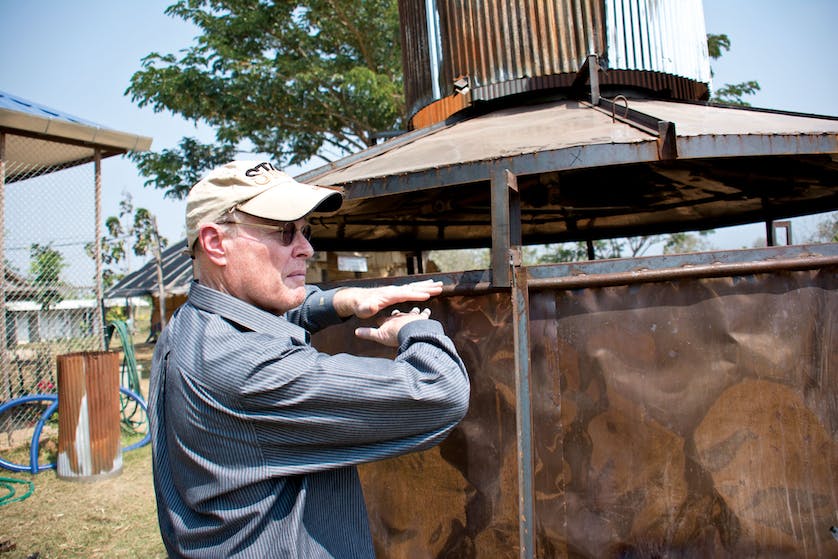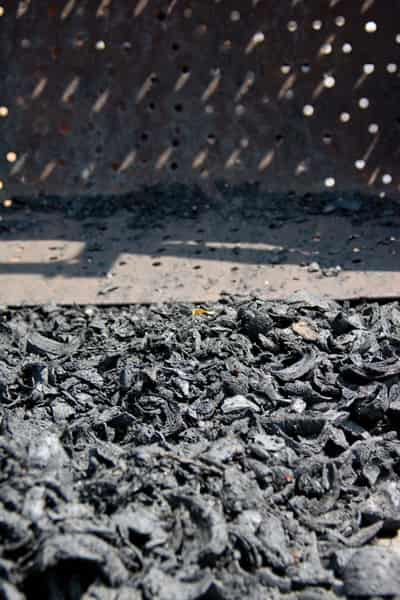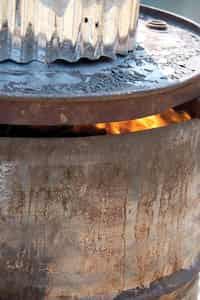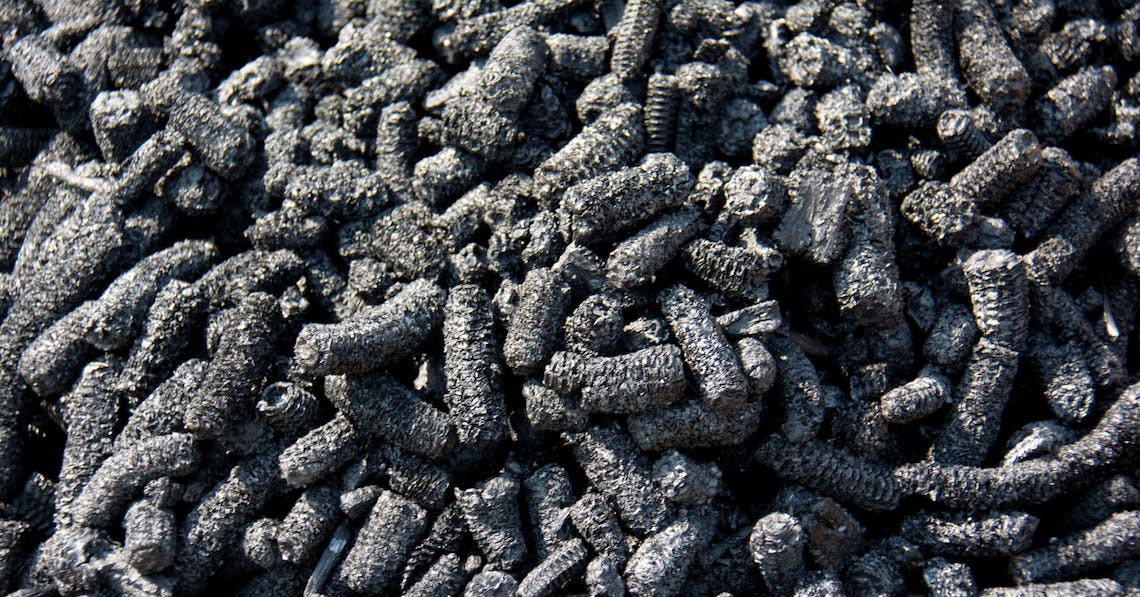Thirty percent of people in the North of Thailand live off less than one dollar a day. Most of these are farmers. Farmers with no formal education. Farmers who have followed farming traditions passed down by the generations, with any new information most often provided via sales pitches by people peddling fertilisers and seeds, with their own very biased agendas. Change is not something that is easily embraced, especially amongst farmers scattered across some very remote terrain. As the burning season begins in earnest, farmers ready their fields and the residents in Chiang Mai close their windows, don their masks and get down to another year of anti-smoke campaigns.

Michael Shafer explaining how it all works.
“We can’t tell the farmers to stop burning when they have no other options,” said Michael Shafer, Director of Warm Heart Foundation (warmheartworldwide.org), a grassroots community development organisation servicing the rural poor of Northern Thailand based in Phrao District, in response to the government’s hardline approach on burning. He explains that blanket bans just don’t work.
The Problem

If we ignore all the other crops, Chiang Mai province devotes 630,000 rai of land to rice production alone. When all the rice is harvested, farmers are left with almost 200,000 tons of rice straw, and 80,000 tons ofrice stubble. Rice stubble is the lower stems of the rice plant, often left in the ground and then burnt before the next grow season begins. Ifwe assume that halfofthe rice straw is used as feed and organic mulch fertiliser for crops such as mushrooms and onions, that will still leave around 100,000 tons ofrice straw and 80,000 tons ofstubble to be burnt each year. According to Warm Heart’s research, this will generate over one million kilograms of smoke. That’s almost 77 billion cigarettes worth of smoke – around 45,000 cigarettes per person for the entire population of Chiang Mai annually.
And this is just the rice.
“Smoke is a real public health issue,” said Shafer after explaining the numbers. “When farmers burn, they do what is called a field burn, which burns at very low temperatures over the entire field, resulting in the release of many toxic greenhouse gasses that create the smog.” This smoke that is released in the form of many gasses and particles is described by the scientific community as black carbon. In fact, black carbon is a relatively new term and allegedly accounts for almost half of the cause of the world’s global warming.
The World Health Organisation reports that there is no ‘safe level of exposure’ to both PM10 particles and PM2.5 particles. PM10 particles are the ones that get stuck in your lungs and make it harder to breathe, whereas PM2.5 particles can get into your blood stream and do serious damage. In fact, Chiang Mai has a much higher rate oflung cancer compared to the rest ofthe country – a direct correlation to the smoke that plagues us every day.
Yet even after all this information, farmers continue to burn. According to Shafer, this is not because they don’t care about the smoke or worry about their health, but because there is really no other option. They suffer just like the rest of us, with the added pressure of pointing fingers from the cities.
“What the people in the city forget is that the farmers up the mountains have it so much worse,” Shafer says. “Their homes don’t have air conditioning or even windows to keep out the smoke. They have to work outside around the smoke every day, and they are exposed to much more than people in the city are.” He jokes that city people are far too precious, and that in reality, ifthe smoke didn’t make it down to the city (which most of it doesn’t already), nobody would care.
It’s a strong point.
A Possible Solution?
“I had to come up with awayto reduce the smoke, but in a way that farmers and governments would support and promote,” said Shafer.
In 2013 he first learnt about biocharat conference hosted in Chiang Mai byECHO Asia, a foundation that gathers solutions that promote sustainable farming techniques and methods of solving hunger problems.
“Biochar is basically carbon,” he explained. “It’s the second best thing to Activated Carbon which is usually a substance reserved for big companies who can afford the expensive manufacturing costs.”

Activated Carbon and Biochar are both forms of inert carbon that has very small pores, and can be used as soil fertiliser, to neutralise low pH soils, absorb smells in animal pens, be used as an animal feed enhancer, filter chemicals and pesticides from water and reduce the need for synthetic fertilisers in farms, to name just a few functions. “Biochar is also carbon negative,” explained Shafer. “This means that when you burn it, you actually take away carbon that was absorbed by the plant, which would otherwise be released into the atmosphere, and put it in the ground where it will stay for thousands of years.”
Not long after the conference, Shafer was invited to Pun-Pun, a well-known NGO not far from Chiang Mai, for a demonstration on biochar making. Unfortunately he was left feeling unimpressed. “The demonstrated technology struck both me as unsafe, inefficient, labour-intensive and way too small to be useful in a real world setting.” Seeing the potential, Warm Heart Foundation set to work designing a biochar oven that was both affordable and easy to use. By early 2014, they had their first set of prototypes. One of their larger systems permits a single, elderly individual to fill, burn, and quench six barrels ofcorn cobs in less than two hours, producing 180kg of biochar each day, or one tonne per week.

The ovens use pyrolysis to burn organic material without the presence of oxygen (the same process we use to make charcoal), locking in carbon and creating the incredibly porous biochar. As it heats up to around 600 degrees, the heat vaporises all the smoke particles before they escape meaning biochar ovens are also smoke free.
Soon Shafer was approached by the US Consulate of Chiang Mai who offered to help acquire a grant to fund Warm Heart’s work and with that money, they expanded, collated data and finally began to extend their research towards a hook that they could use to convert the local farmers to biochar.
Farmers Unconvinced
For the rest of 2015, Warm Heart turned their focus towards how to utilise the biochar as a sustainable product that could have the potential to be bought, sold and traded. “Biochar alone is not great for farmers,” Shafer explained. “If you just put it in your soil, it will absorb all the water and minerals and starve crops. It needs to be fertilised first – but when it is, it is incredible.”
“To fertilise biochar, all you need to do is soak it in pig’s piss,” Shafer said matter-offactly. “One corncob turned into biochar has the surface area of roughly one hectare, so it is a great absorbent.” In fact, farmers can fertilise with whatever comes to hand; manure, urine, compost etc. Yet it doesn’t stop there. Biochar also adsorbs minerals and chemicals that “makes each biochar lump a ball of powerful fertiliser that boosts the growth of microbe soil communities which can last forever, unlike conventional synthetic fertilisers that are quickly washed away.”
In addition to being great for the soil, fertilised biochar sits at a slightly alkaline pH of 8. “This is ideal for the clay soils of Thailand which are quite acidic. It brings their pH up from around 4.5pH to a neutral pH of 7, increasing plant growth and the variety of crops.” As it is so absorbent, once incorporated into soil it can hold water for up to three days longer than regular soil, reducing the labour it takes to water crops.
In just a few years, farmers who switch to biochar fertiliser will find that their soils are pretty much always fertile and they can become totally self-sufficient.
Yet despite being a great fertiliser, the local farming communities still didn’t see the benefits. “Many farmers don’t really understand net profit,” Shafer said. “They understand profit to be the money they make after selling their crop at a market. They don’t take into account the cost offertiliser, labour or water. This is why so many farmers have crippling debt, and why they don’t go for biochar, as it slightly reduces yield in the first few years.” Even after explaining that yield would have to drop beyond 50% before a net loss would be made (as it removes some labour costs and the cost of fertiliser), it was still not welcomed.
Shafer needed something that both farmers and governments could benefit from, that would create a tradeable market, and offer a whole new income to those who create biochar. With other countries far more advanced in their uses of biochar, it was not long before Shafer came up with an idea that has the potential to make a whole new market for people to trade in – while cleaning the air at the same time.

Creating Demand
15 years ago, the government pledged to give every Thai citizen access to clean drinking water, something that is still yet to be a reality. The water in our taps is filtered for chemicals, chlorine and all kinds of microbes, but with most of the province’s water collected from surface runoff, pesticides remain in our tap water. “The pesticide levels are not even recorded by the authorities,” Shafer exclaims. “We are all washing in pesticide water!”
However, for Shafer, it was this disappointing fact that gave him a way to create a demand. A way for farmers to make money from biochar.Biochar is often used in water filtration across the world, with the ability to absorb forms of chemicals (such as pesticides) where conventional filtration techniques fall short. According to Shafer, if Thailand began to use biochar in water filtration plants, we would see biochar quickly turn into a locally made, high-demand product, creating monetary incentives for farmers and in turn, will fix the smoke problems, clean our water and h elp prevent the impending soil fertility crisis.
It’s a win win situation, but Warm Heart’s big plan is still in its infancy.
“If I could convince the government to make a rule that for every community over 250,000 people, pesticides must also be filtered out of the water, like in Europe, then that can create the demand,” explains Shafer. This could create a snowball of positive effects for the entire country: famers could begin to make money from their waste, save money on fertilising their soils and choose from more crops to grow. The local population will know that their water is cleaner and safer, increasing support for the local governments who implement the law changes…and the almost-forgotten by-product is that the air will be smoke free too.
Burning Interest
In January 2016 Shafer held a meeting with the deputy governor who then followed up with a visit to Phrao. “At the end of the presentation, he told all of the officials who attended (Chiang Dao, Mae Chaem, Phrao and Samoeng) that they were to adopt our technology,” Shafer said happily. This was swiftly followed by 80 local government officials joining a one-day training programme followed by another programme with 40 farmers from Phrao the next day, who in turn have organised their own training days to spread the word to the local farmers in their area.

So far Warm Heart knows of several farmers and businesses adopting the biochar production. At least two corn shucking businesses in Chiang Dao who produce 100,000 kg ofcorncob waste a year have begun to use the biochar ovens that Warm Heart have designed. That’s another seven billion cigarettes-worth less of smoke in our air. Another company is also replacing their gas burners used to dry corn kernels with biocharovens, both burningcorncobs smoke-free and doing away with burning fossil fuels to dry the kernels.
While standing over a demonstration burn in one of their more basic biochar ovens, Shafer said that all he wanted to do was to “save the world.” A tall order. But some of the most marginalised people ofThailand’s society could soon become empowered, earn more money than they ever did before, and be hailed as heroes when all the smoke disappears.
What clearly needs to happen is for progressive politicians to see the vast number of positive outcomes of creating a serious demand for biochar, and make that demand a reality. “Ifwe lived in a perfect world, farmers would all just switch to biochar to save the air, but with no immediate profit very few are interested,” said Shafer slightly deflated. But with support from governments, organisations, and freelance campaigners such as Marisa Marchitelli [Citylife February 2016 cover story] there is no doubt that given the right circumstances and support, Warm Heart’s biochar ovens could really change Northern Thailand; empowering farmers, cleaning our water and giving us back our sorely missed smoke-free Chiang Mai.
